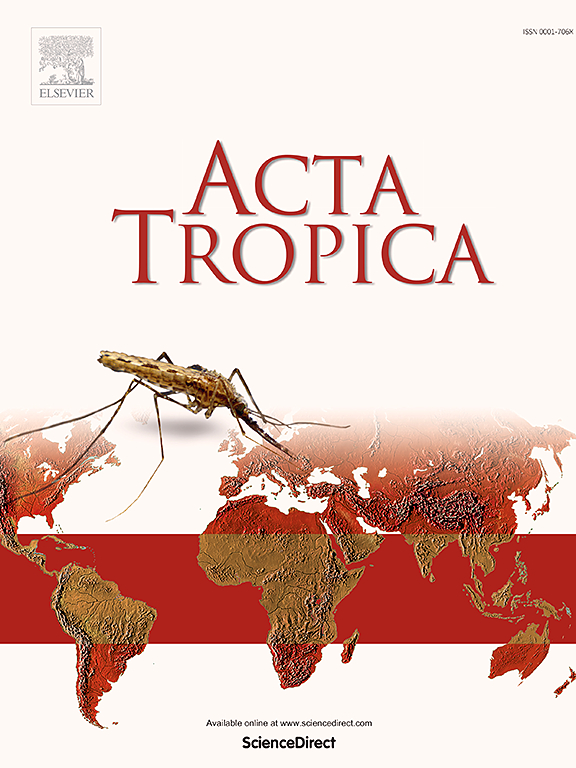Population genetic structure of Biomphalaria snails found in East Africa’s river systems
IF 2.1
3区 医学
Q2 PARASITOLOGY
引用次数: 0
Abstract
There is a need for current and more detailed information on the population genetic structure of Biomphalaria snails in East Africa’s river systems. Here, we examine the population genetic structure of Biomphalaria populations in East Africa using the mitochondrial cytochrome oxidase 1 (CO1) gene and the internal transcribed spacer 2 (ITS-2) region of nuclear ribosomal DNA. Biomphalaria snails were found at 31 of the 172 sites surveyed, with B. pfeifferi snails found at 23 sites and snails of the Biomphalaria ‘Nilotic Species Complex’ found at 9 sites. Biomphalaria pfeifferi formed a monophyletic group in both CO1 and ITS-2 phylogenetic trees. Similarly, the ‘Nilotic Species Complex’ also formed a monophyletic group in both CO1 and ITS-2 trees but while some individual species within the 'Nilotic Species Complex’ were monophyletic, others were not monophyletic and intermingled in the trees.
A total of 17 CO1 haplotypes (3 shared haplotypes and 14 private haplotypes) were identified for B. pfeifferi populations with a haplotype diversity of 0.798 and nucleotide diversity of 0.004. For ITS-2, a total of 27 B. pfeifferi haplotypes (3 shared haplotypes and 24 private haplotypes) were identified, with a haplotype diversity of 0.471 and nucleotide diversity of 0.002. For the ‘Nilotic Species Complex’, a total of 21 CO1 haplotypes (all private) were identified, with a haplotype diversity of 0.897 and nucleotide diversity of 0.018. For ITS-2, a total of 23 ‘Nilotic Species Complex’ ITS-2 haplotypes (3 shared haplotypes and 20 private haplotypes) were identified with a haplotype diversity of 0.951 and nucleotide diversity of 0.008.
Analysis of Molecular Variance (AMOVA) revealed low genetic variation within B. pfeifferi populations (between 4.83 % and 5.86 %) and high genetic differentiation among populations (between 94.14 % and 95.17 %). For the ‘Nilotic Species Complex’, the genetic diversity was moderate within populations (between 27.83 % and 31.96 %) and among populations (between 68.04 % and 72.17 %). Geographical distance plays a role in bringing about genetic differentiation among Biomphalaria populations in East Africa’s river systems, with sequences from Biomphalaria populations that were found at sites close to each other geographically, taking positions close to each other in the phylogenetic trees.
B. pfeifferi populations studied herein were characterised by low intra-population genetic diversity and high inter-population genetic diversity suggestive of low levels of gene flow and high levels of inbreeding. In the case of the ‘Nilotic Species Complex’, there was moderate to high levels of intra-population genetic diversity and moderate to high levels of inter-population genetic differentiation suggestive of high levels of gene flow. It was established that the population genetic structure of Biomphalaria snails is a possible determinant of the success of S. mansoni infections in the snails.
东非河流系统中发现的生物phalaria蜗牛的种群遗传结构。
目前有必要对东非河流系统中Biomphalaria蜗牛的种群遗传结构提供更详细的信息。在这里,我们利用线粒体细胞色素氧化酶1 (CO1)基因和核糖体DNA的内部转录间隔区2 (ITS-2)区域研究了东非Biomphalaria种群的遗传结构。在调查的172个地点中,有31个地点发现了Biomphalaria蜗牛,23个地点发现了B. pfeifferi蜗牛,9个地点发现了Biomphalaria 'Nilotic Species complex的蜗牛。在CO1和ITS-2系统发育树中,feifferi生物phalaria形成了一个单系群。同样,“尼罗河物种复合体”也在CO1和ITS-2树中形成了一个单系群,但“尼罗河物种复合体”中的一些个体物种是单系的,而其他物种则不是单系的,并且在树上混杂。共鉴定出17个CO1单倍型(3个共享单倍型,14个私有单倍型),单倍型多样性为0.798,核苷酸多样性为0.004。ITS-2共鉴定出27个B. pfeifferi单倍型(3个共享单倍型,24个私有单倍型),单倍型多样性为0.471,核苷酸多样性为0.002。“尼罗河物种复合体”共鉴定出21个CO1单倍型(均为私有),单倍型多样性为0.897,核苷酸多样性为0.018。对ITS-2共鉴定出23个“Nilotic Species Complex”ITS-2单倍型(3个共有单倍型和20个私有单倍型),单倍型多样性为0.951,核苷酸多样性为0.008。分子变异分析(AMOVA)表明,不同居群间遗传分化程度较高(94.14% ~ 95.17%),居群间遗传变异程度较低(4.83% ~ 5.86%)。种群内(27.83% ~ 31.96%)和种群间(68.04% ~ 72.17%)的遗传多样性处于中等水平。地理距离在东非河流水系Biomphalaria种群之间的遗传分化中起着重要作用,来自Biomphalaria种群的序列在地理位置上彼此接近,在系统发育树中占据彼此接近的位置。本文研究的肥猪群体具有低种群内遗传多样性和高种群间遗传多样性的特征,表明低水平的基因流动和高水平的近交。在“尼罗河物种复合体”的情况下,存在中等至高水平的种群内遗传多样性和中等至高水平的种群间遗传分化,这表明了高水平的基因流动。结果表明,钉螺种群遗传结构可能是钉螺感染曼森氏球菌成功的决定因素。
本文章由计算机程序翻译,如有差异,请以英文原文为准。
求助全文
约1分钟内获得全文
求助全文
来源期刊

Acta tropica
医学-寄生虫学
CiteScore
5.40
自引率
11.10%
发文量
383
审稿时长
37 days
期刊介绍:
Acta Tropica, is an international journal on infectious diseases that covers public health sciences and biomedical research with particular emphasis on topics relevant to human and animal health in the tropics and the subtropics.
 求助内容:
求助内容: 应助结果提醒方式:
应助结果提醒方式:


